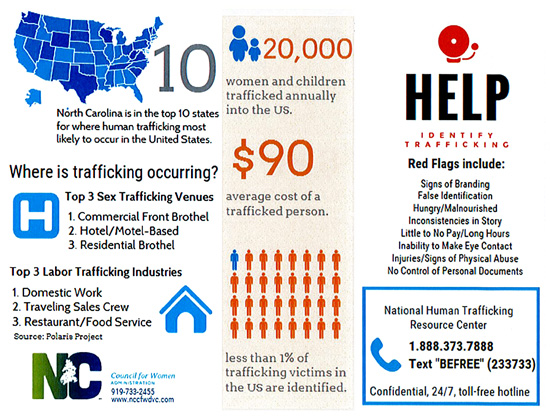by Kiricka Yarbough Smith
Human trafficking is one of the fastest growing crimes in our country, and it’s on the rise.It is happening right now in North Carolina.
There are two kinds of human trafficking. Sex trafficking is recruiting, harboring, transporting, providing, or obtaining a person for a commercial sex act that is induced by force, fraud, or coercion. When the victim is under age 18, no force, fraud, or coercion is necessary. In other words, minors involved in sex trafficking are always victims regardless of their knowledge of or agreement to commercial sex acts.
Labor trafficking is recruiting, harboring, transporting, providing, or obtaining a person for labor or services, through the use of force, fraud, or coercion for the purpose of subjection to involuntary servitude, peonage, debt bondage, or slavery.
Human trafficking is the second most profitable industry in the world, worth $150 billion annually. Millions of men, women, and children are trafficked every year. The International Labour Organization estimates there are 21 million human trafficking victims globally.

Youth Most at Risk
Traffickers target the vulnerable. This can include young people with a history of sexual abuse, dating violence, low self-esteem, or minimal social support.
Runaways and homeless youth are particularly endangered. One in three runaways who end up homeless are approached by a trafficker in the first 48 hours. Youth who identify as LGBTQ are also at risk because they are more likely to face discrimination and homelessness.
Youth involved with child welfare are also vulnerable. They often lack a strong family foundation, which teaches a healthy model of love and trust. This creates an opening for traffickers to exploit. (For more on why young people in foster care may be at heightened risk of exploitation, see this testimony from a trafficking survivor.)
Traffickers
A trafficker can be anyone who has influence over a minor—a friend, boyfriend, parent, brother, cousin, counselor, teacher, coach, or even a peer. Traffickers are not always involved in organized crime or gangs. They can be any age, gender, or race.
Traffickers exploit their victims by posing as friends or lovers, and even take on the role of surrogate family. Many initially shower their victims with material items and offers of protection. Then, once they have victims’ trust, traffickers exploit them. Traffickers use violence and blackmail to keep victims under their control and to shame them. Because of the manipulation, victims often lose all feelings of hope and self-worth. Even if there is a chance to escape, the psychological chains traffickers use often keep victims from leaving.
Recognizing Victims
Trafficking victims often try to avoid identification, so it helps to know the signs. The following are possible indications:
- Distrusts law enforcement
- Avoids eye contact
- Lacks medical care or is denied medical services by trafficker
- Appears malnourished or shows signs of abuse, physical restraint, confinement, torture, or branding
- Has a lack of control, has few or no personal possessions, is not in control of his/her own money, financial records, identification documents, and/or is not allowed to speak for themselves
- Has numerous inconsistencies in his/her story, no sense of time, doesn’t know what city they are in
- Poor mental and/or physical health, such as fear, anxiety, depression, paranoid behavior
If you see these signs further inquiry may be warranted. If you suspect trafficking is taking place, contact the National Human Trafficking Resource Center (888/373-7888) or text “BEFREE.”
Project C.O.P.E.
At the NC Council for Women and Youth Involvement, we believe that through collaboration, outreach, protection and education, we can improve and expand mentoring services for those at risk of sexual exploitation. In 2015, we were awarded a grant from the NC Governor’s Crime Commission to fund Project C.O.P.E. (Collaboration, Outreach, Protection, and Education). The four primary goals of Project C.O.P.E. are to:
- Increase awareness about the risks of commercial sexual exploitation
- Promote resources and services available for children at risk of exploitation
- Strengthen existing academic, extracurricular, and mentoring programs to serve youth more effectively
- Strengthen protective factors among previously exploited children and youth
Project C.O.P.E. provides trainings for school personnel, students, and parents on how to prevent trafficking in their community. It is important for parents and caregivers to teach children about healthy relationships and personal boundaries. Parents should be aware of their child’s friends and other relationships because traffickers often try to build friendly relationships with victims to gain their trust prior to recruiting them.
Since human trafficking is increasingly happening through technology, parents should establish guidelines for and monitor the use of internet and social media. It’s important to create a space where young people feel comfortable coming to their parents about situations that make them feel uncomfortable or exploited. Community involvement and awareness is a critical part of the fight against human trafficking.
For more information, please visit www.councilforwomen.nc.gov or contact Project C.O.P.E.’s Kiricka Yarbough Smith (919-733-2455; [email protected]).


